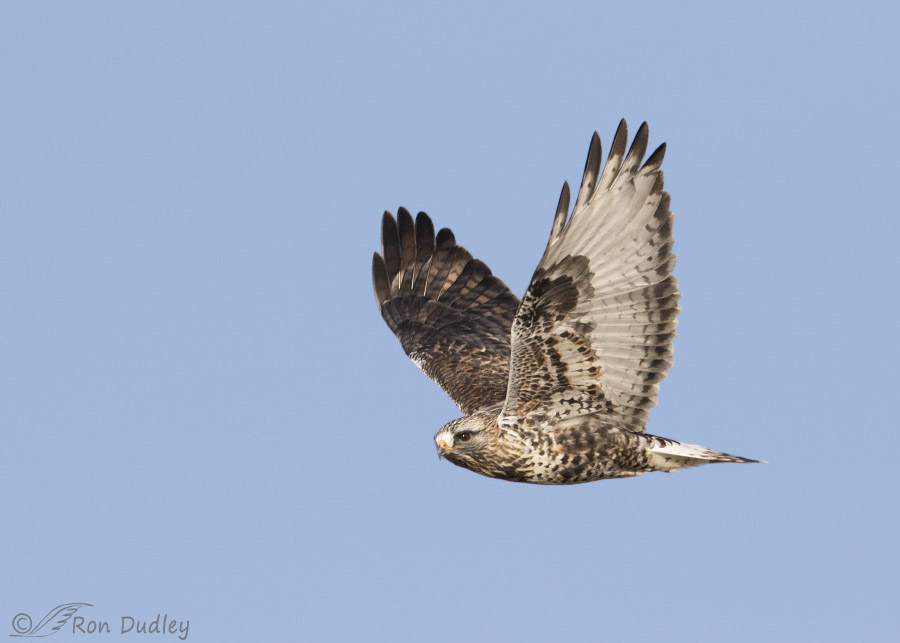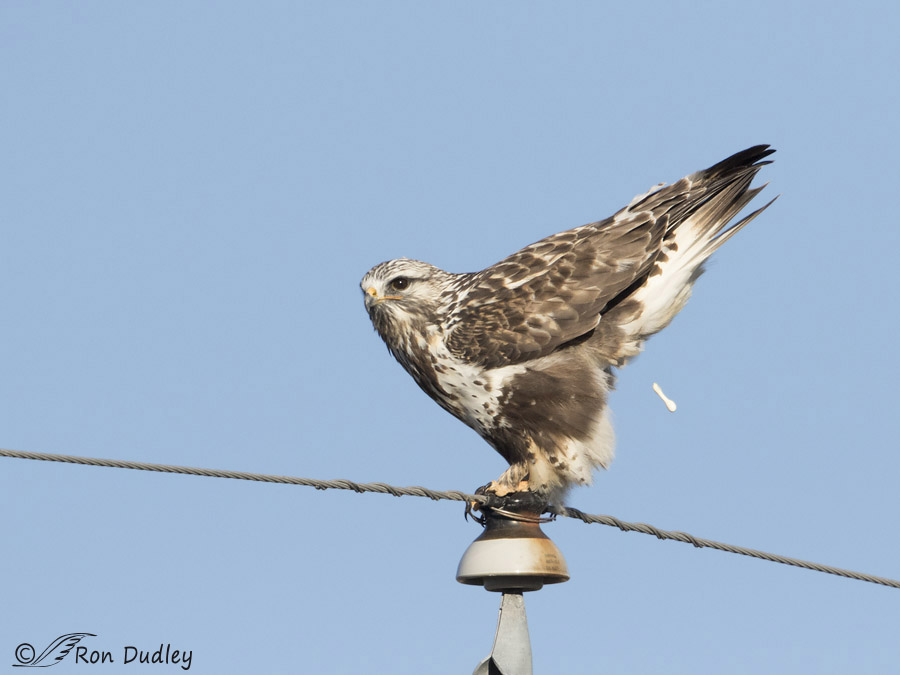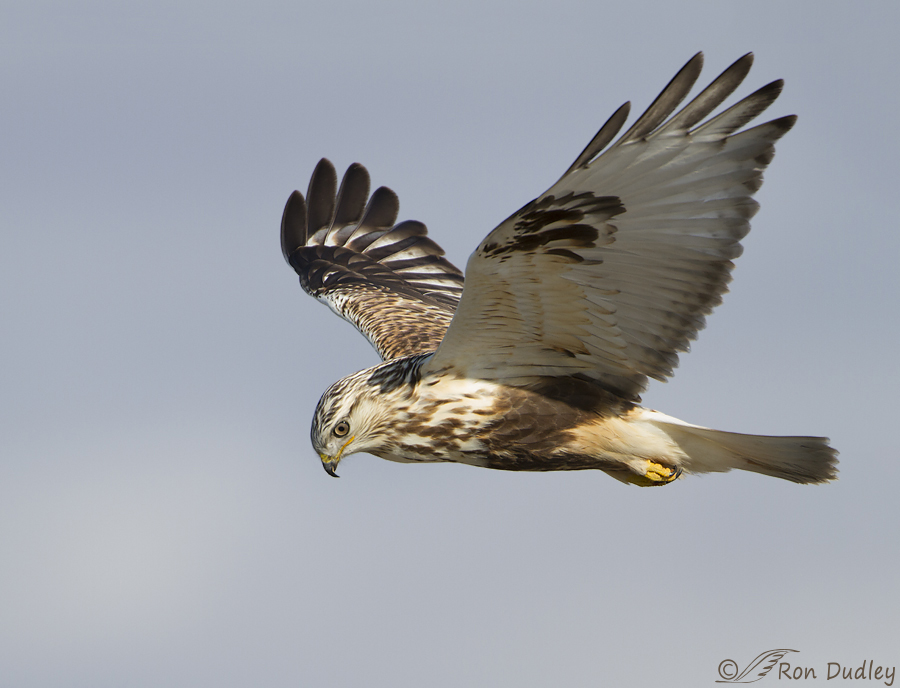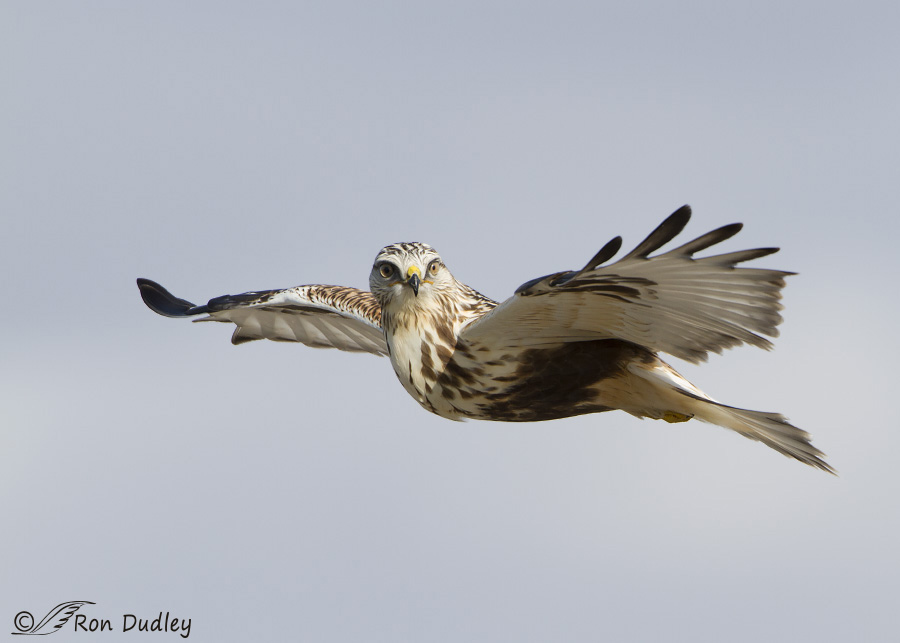It’s that time of year – the “roughies” are here so I thought it might be helpful to review some basics about sexing them and distinguishing juveniles from adults. Interestingly, the Rough-legged Hawk is our only buteo that exhibits true sexual dimorphism so adults can be sexed based on plumage.

1/2500, f/7.1, ISO 500, Canon 7D Mark II, Canon EF 500mm f/4L IS II USM + EF 1.4 III Extender, not baited, set up or called in
Three days ago I photographed this adult male Rough-legged Hawk as it flew past me near the Promontory Mountains in Box Elder County. He wasn’t particularly close but I was happy to get the shots because most roughies I see are juveniles (or adult females). I’m not sure why that’s the case but it most definitely is.
I know this bird is an adult because of its very dark brown eye – eyes of juveniles are noticeably lighter colored, either pale brown, light gray or yellow. And I know it’s a male because it’s so dark. The darker colors on adult males are almost blackish but on juveniles of both sexes and adult females those darker colors are brown and buff.

1/5000, f/7.1, ISO 800, Canon 7D, Canon EF 500mm f/4L IS II USM + EF 1.4 III Extender, not baited, set up or called in
This is a defecating adult female – an adult because of the dark eye and a female because her basic plumage color is brown/buff and not blackish.

1/1600, f/6.3, ISO 500, Canon 7D, Canon EF 500mm f/4L IS USM + EF 1.4 III Extender, not baited, set up or called in
This bird is a juvenile. I know it’s a juvenile because of its light eye but I don’t know its sex at this age. If it’s a male it will turn darker (almost blackish) when it loses its juvenile plumage. The plumage colors of adult females and juveniles of both sexes are similar.
Ok, that’s pretty much it – the basics of sexing adult Roughies and identifying juveniles. However, there are a couple of caveats:
- These plumage guidelines apply only to light morphs. But only a small percentage of Rough-legged Hawks are dark morphs and I rarely see them so I find the guidelines very useful.
- These are only the basics of sexing roughies. There are several other more subtle plumage differences between adult males and females that experts and experienced birders use to distinguish the sexes. But most of us are far from experts (including me) and I think this is a good start for the rest of us.
Now that Rough-legged Hawks are here for the winter (their winter range includes almost 3/4 of the continental United States) I hope some of my readers will feel encouraged to practice sexing them and distinguishing juveniles from adults.
Ron
Ok, now it’s quiz time. Based on what you’ve (hopefully) learned above what do you know (and possibly not know) about the sex and age of the following Rough-legged Hawk? Don’t scroll down too far below the image before you come up with your answer. I’ll provide the correct answer further below the image.

1/1000, f/8, ISO 500, Canon 7D, Canon EF 500mm f/4L IS USM + EF 1.4 III Extender, not baited, set up or called in
This roughie is a juvenile. We know it’s a juvie because of the light eye. Because it’s a juvie we don’t know its sex.
For what it’s worth I adore this flight pose. The bird was kiting in the wind and raised its head in an effort to look over the nearby raised causeway road to Antelope Island. The last two images are actually of the same bird.
Note: I make no pretensions at being a raptor plumage expert so if I’ve made any errors feel free to correct me.


Thanks for the great images and information. I especially like the last photo. If I were to give it a caption, the juvie would say, “Look at me, I’m flying!”
Thanks Ron! You just helped me identify a large hawk that has been visiting the last few weeks. He comes to a tree a few yards down to wait for me to put bird food out so the pigeons come. I have taught the pigeons well to not come close while he is in the tree. If they are eating when he comes I go out and stand there until he leaves. I know he needs to eat but I would prefer if he not eat in my yard. He is beautiful. I love the last pic of the Julie. He/she looks like he is having fun!
Juvie not Julie
Nice pictures once again. Interesting about the eye colors etc. I am never that close to them to tell if the eyes are light or dark. I guess people with fancy cameras can see the difference. Any way thanks for the education. \
Beautiful pictures and always learning from Dr. Dudley!! Still no Roughies here counted 22 Redtails today
Woo Hoo.
Computer issues have kept me away for a few days so I am glad to be back.
And even gladder to answer your quizz correctly, after reading the post.
I hope your coming months are filled with Roughies.
Welcome back, EC. You’ve been missed!
Thank you.
Later I hope to find/make time to explore the posts I missed.
Thank you so much for these photos and the information! I’m not sure I have ever seen a photo of a raptor in flight like the last one. I adore it!
Yes, I think that flight posture is quite unique, Pat. Thank you.
Beautiful photos and information too. I love the last shot, it is one of my favorites.
Thank you, April.
I’ve always used the dark belly band vs speckled/streaked belly as the clue between adult females and males. With juvies like females only lighter. Birds of North America mentions the ‘flash’ on the wings in juvies that Dick pointed out (light base to primaries) but says that’s way more prevalent in Asian RLHA’s; that those in North American don’t show that as much. And also mentions as both Ron and Dick say, that there arae cross-overs that don’t fit the male/female plumage rules. Hadn’t thought of looking for eye color, though – we only rarely get them into rehab and never more than one at a time. We just released one, though, that we’d had for almost a year – wish I’d had this post while she was still with us but we know she was a youngster, since she came into the rehab center in AK as a very young fledgling – then was sent here since she’d missed migration. We do have two roughies as display birds, though, so I might go take a more detailed peek – but they definitely demonstrate a dark belly band vs streaked, and always have. One we’ve had for 20 years, the other was injured in 2000 but we’ve only had her since 2003. Wish I’d thought to make note of eye color back in 1997, when the male came in!
I use that dark belly band too, Louise. There’s a fair amount of variation and overlap between the sexes so at times it can be a little tricky. Eye color is often easy for me to see in the field with my lens.
You say you can tell it’s a juvie becsuse it has a light eye…with eagles it’s the opposite…the eyes of the young are dark but they get more golden and lighter as they age…the eyes of older eagles becoming quite light….right? Interesting how the eye color of so many animals change as they age….I wonder why…..
Right.
Thanks for the lesson! I saw three Roughies yesterday and never thought to look at plumage and eye color. Of course, the only picture I got was of the rump!
Ha, I’m all too familiar with those butt shots, Jonelle…
I was pleased to actually get the ID of the last one as a juvenile. That is a great photo, and the bird’s attitude seems very casual compared to every other raptor photo I think I’ve seen. Even though their winter range apparently extends down to far west Texas, I have yet to see one (that I know of). Thank you for the education about distinguishing the sexes and ages of the birds. I’d imagine that could be somewhat difficult in the field.
Yes, it does get more challenging in the field, Susan – especially when the bird is backlit or far away. And when your eyesight isn’t very good, like mine. Having my big lens sure helps though…
Hi Ron,
Nice images of my favorite hawk, thanks! Rough-legged ID is little bit more complicated, however. It turns out that MOST birds that display male plumage are males, but some of those birds are female. Because of that, there are those (including me) who tend to call adult roughies as “male-type” and “female type”. And, in my experience, the adult male-types tend to have paler dorsal aspects, while female (types) and first year birds tend to be more brownish. And, youngsters display a “flash” in the outer primaries, which helps distinguish them from females. Your 3rd image shows it perfectly. Just my two cents worth!
Cheers,
Dick
You’re absolutely right, Dick – it IS more complicated than I’ve presented it. Which is why I said “these are only the basics of sexing roughies. There are several other more subtle plumage differences between adult males and females” but this is a good “starting point”.
I didn’t want to get too complicated for those just beginning to learn this stuff…
Sensational series Ron!
Charlotte
Thanks, Charlotte.
What a fun lesson, professor. In parrots, many of the species are dimorphic in eye color so you can tell that way. Some, like the fabulous Eclectus, are color dimorphic with the females being red and purple and the males are all green.
Thank you, Arwen.
Interesting images and accompaning comments..especially love the last…so graceful! I keep going back to yesterday’s amazing images….you also took some equally amazing shots of a gull(?) biting the tail ofvan eagle…would love to see them again….
Patty, If memory serves I missed those shots of gulls biting the tails of eagles. Don’t think I have any…
You didn’t miss them…you posted them. They were incredible! I remember being struck by the audacity of the smaller birds.
I remember describing what I saw but don’t remember having the images. Don’t think that’s something I’d forget but when it comes to my memory I guess anything’s possible…
Your blog is the one I follow…it was one of your images that I saw….you just forgot…you take( and cull!!!) so many shots…no one else except Mia or Roger Burnard would get such shots….they’re in your archives somewhere (I hope!!!)….
Beautiful! The last photo is REALLY a nice pose by the juvie. Thx for giving some clues regarding adult/juvenile adult male/female:) With that note we “probably” had an adult male around and a couple of either female or juvie tho they are gone now. 2 got hit on the road in different places which leads me to believe they were juvie – didn’t stop to examine.
Dang, sorry to hear about those road kills, Judy. Juvies can be pretty naïve when it comes to roads and traffic.
Yeh – know they can’t all live BUT!
I hear you, Judy. We’ve had an explosion of small animal “Darwin Awards” lately. There must have been an especially clueless batch of squirrels born in my neighborhood last season. It is tough to see. On the other hand, since our dog died, a squirrel has taken up residence in our other orange tree, so I know there are at least two who are beating the odds (and beating me to the tastiest oranges!).
I like the story about this juvie checking out the scenery that the last two shots give me. As always, thank you for some “edumacation” to start my Sunday morning.
As always, thank you for some “edumacation” to start my Sunday morning.
Marty, I had a blast with this kiting bird for quite a while. Because it was kiting it made an easy target for my lens and I got many nice shots, including several poses similar to that one.